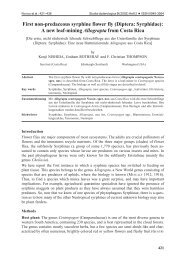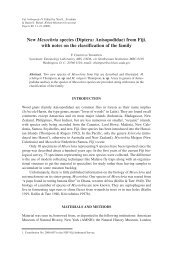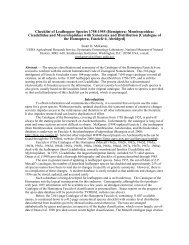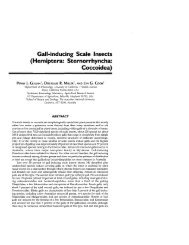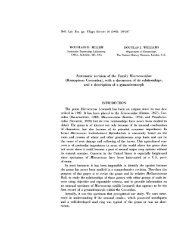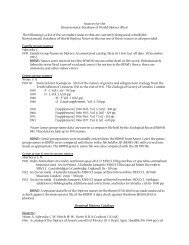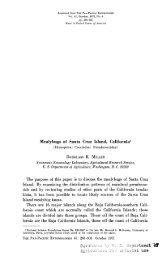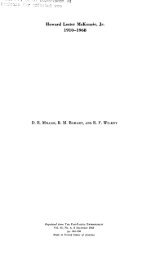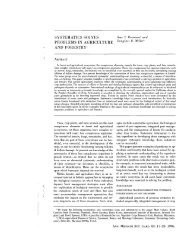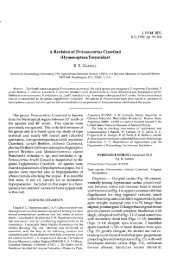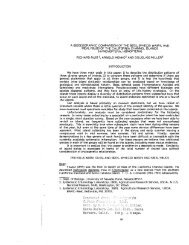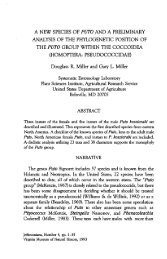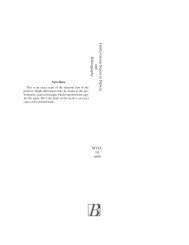Fruit Fly Expert Identification System and Systematic Information
Fruit Fly Expert Identification System and Systematic Information
Fruit Fly Expert Identification System and Systematic Information
You also want an ePaper? Increase the reach of your titles
YUMPU automatically turns print PDFs into web optimized ePapers that Google loves.
Norrbom Status of Knowledge 39<br />
prep.). There are also keys for the faunas of the following more<br />
restricted areas: Britain (White 1988), northern China (Zia &<br />
Chen 1938), central Europe (Merz 1994[3343]), eastern Europe<br />
(Richter 1970), Israel (Freidberg & Kugler 1989), Japan (Ito<br />
1983-1985), <strong>and</strong> Korea (Kwon 1985).<br />
Revisions, monographs <strong>and</strong> keys are listed in the References<br />
section (“REFS”) under each family group <strong>and</strong> genus<br />
group taxon in the database. Because of the unstable higher<br />
classification of the Tephritidae, users should be forewarned<br />
that many keys to genera or higher groups may be less reliable<br />
than regional or local keys that do not strictly follow a classification.<br />
The following publications include keys to genera of<br />
higher taxa of Tephritidae:<br />
Keys to subfamilies <strong>and</strong> tribes have been provided by<br />
Hering (1947), Aczél (1953[24]), Hardy (1973, 1974[1943]),<br />
Foote (1980), Ito (1983), Kwon (1985), Hancock<br />
(1986[1890]), Freidberg & Kugler (1989), White (1988), <strong>and</strong><br />
Merz (1994[3343]). Most of them conflict in classification <strong>and</strong><br />
are difficult to use.<br />
Phytalmiinae — There is no comprehensive generic key.<br />
Acanthonevrini — Most Oriental <strong>and</strong> Australasian genera<br />
were included in one or more of the following works: Hardy<br />
(1973, 1974[1943], 1980[1949], 1986[1962], 1988), Kapoor<br />
(1993), <strong>and</strong> Permkam & Hancock 1995[3795]. The Afrotropical<br />
genera were included under Trypetinae in the key of Hancock<br />
(1986[1890]), <strong>and</strong> the key to the species of four<br />
Afrotropical genera by Munro (1967[3521]) is also useful.<br />
Blepharoneurini — The four genera have never been keyed<br />
as a group.<br />
Epacrocerini — Three of the genera were revised by Hardy<br />
(1982[1954]), <strong>and</strong> all four were included in the key of Hardy<br />
(1988[1964]).<br />
Phascini — The six genera were included under Acanthonevrina<br />
<strong>and</strong> Gastrozonina by Hardy (1986[1962],<br />
1988[1964]).<br />
Phytalmiini — There is no comprehensive generic key.<br />
McAlpine & Schneider (1978) keyed four of the genera. Some<br />
genera have been keyed <strong>and</strong>/or revised under Adramini or<br />
Gastrozonina by Hardy (1986[1961], 1988[1964]).<br />
Trypetinae — The genera of the USA <strong>and</strong> Canada are<br />
included in the key of Foote et al. (1993), <strong>and</strong> those of the<br />
Neotropical Region <strong>and</strong> Nearctic Mexico were keyed by Foote<br />
(1980). The Afrotropical genera, except the Dacini, were keyed<br />
by Hancock (1986[1890], 1991[1895]). Many Palearctic genera<br />
were keyed by Hendel (1927[2109]), <strong>and</strong> others were<br />
included in keys to local areas listed above under that region.<br />
Most Oriental <strong>and</strong> Australasian genera were included in keys<br />
by Hardy (1973, 1974[1943], 1987[1963], 1988[1964]),<br />
Kapoor (1993), Permkam & Hancock (1995[3794],<br />
1995[3795]), <strong>and</strong> Shiraki (1933, 1968).<br />
Adramini — There is no comprehensive generic key.<br />
Many, but not all, of the Oriental <strong>and</strong> Australasian genera were<br />
included in keys by Hardy (1973, 1974,<br />
1983[1958], 1986[1961]), Kapoor (1993), <strong>and</strong> Permkam &<br />
Hancock 1995[3795]), <strong>and</strong> the Afrotropical genera were keyed<br />
by Hancock (1986[1890]).<br />
Carpomyini — There is no key strictly to the genera of this<br />
group, although they are included in various regional or local<br />
keys. Norrbom (1994[3663]) provided a key to four American<br />
genera of Carpomyina.<br />
Dacini — All three genera of Dacini were included in the<br />
key to economically important genera of White & Elson-Harris<br />
(1992). Munro (1984) revised the Afrotropical species, although<br />
most of his proposed generic <strong>and</strong> suprageneric names<br />
have not been accepted. Drew (1989[232]) keyed the genera,<br />
subgenera <strong>and</strong> species of the Australasian Region. For the<br />
Oriental Region, most species are included in one or more of<br />
the following works: Hardy (1973, 1974[1943], 1982[1952],<br />
1983[1956]), Wang & Zhao (1989), Tseng, Chen & Chu<br />
(1992), Kapoor (1993), <strong>and</strong> Drew & Hancock (1994[1238]). A<br />
key to the Afrotropical genera of Ceratitidina was provided by<br />
Hancock (1987), <strong>and</strong> Hancock & Drew (1994[1901]) <strong>and</strong> Permkam<br />
& Hancock (1995[3794]) keyed most of the Oriental <strong>and</strong><br />
Australasian genera. The Afrotropical genera of Gastrozonina<br />
have been keyed by Hancock (1985[1889]), <strong>and</strong> most of the<br />
Oriental <strong>and</strong> Australasian genera have been included in keys<br />
by Hardy (1973, 1974[1943], 1988[1964]) <strong>and</strong> Kapoor (1993).<br />
Ortalotrypetini — Norrbom (1994[3662]) provided a key<br />
to four of the five included genera.<br />
Rivelliomimini — There is no key including all three of<br />
the genera, but the two Afrotropical genera were included in<br />
the key of Hancock (1986[1890]).<br />
Toxotrypanini — The three genera were included in the<br />
keys of Foote (1980) <strong>and</strong> Foote et al. (1993).<br />
Trypetini — Han (1992) provided a key to most of the<br />
world genera of Trypetina <strong>and</strong> the Chetostoma group. The three<br />
genera of Acidoxanthina are included in keys by Hancock<br />
(1987) <strong>and</strong> Hardy (1987).<br />
Tephritinae — The genera of the USA <strong>and</strong> Canada were<br />
included in the key of Foote et al. (1993), <strong>and</strong> those of the<br />
Neotropical Region <strong>and</strong> Nearctic Mexico were keyed by Foote<br />
(1980). Most Afrotropical genera have been keyed by Bezzi<br />
(1924[470], 1924[469], 1924[472]), Munro (1957[3511]), <strong>and</strong><br />
Freidberg (1987). Many Palearctic genera were keyed by Hendel<br />
(1927[2109]), <strong>and</strong> others were included in keys to local<br />
areas listed above under that region. Most Oriental <strong>and</strong> Australasian<br />
genera were included in keys by Hardy (1973,<br />
1974[1943], 1988[1965]), Hardy & Adachi (1956), Hardy &<br />
Delfinado (1980), Hardy & Drew (1996), Kapoor (1993), Shiraki<br />
(1933, 1968), <strong>and</strong> Zia (1937). The Australian genera were<br />
revised by Hardy & Drew (1996).<br />
Acrotaeniini — There is no key strictly to the genera of<br />
this group. Foote (1980) keyed some of the genera under<br />
Platensinini, but he included others under Trypetinae, Tephritini<br />
<strong>and</strong> Aciurini.<br />
Dithrycini — There is no comprehensive generic key for<br />
this group. Freidberg & Kaplan (1992) revised the Afrotropical<br />
species of Oedaspidina, <strong>and</strong> they <strong>and</strong> Freidberg & Mansell<br />
(1995) provided keys to the Old World genera. The genera of<br />
Cecidocharina have not been keyed as a group, but were included<br />
in keys by Aczél (1953[24]), Foote (1980) <strong>and</strong> Foote et<br />
al. (1993).<br />
Eurostini — The three genera were included in the key of<br />
Foote et al. (1993).<br />
Eutretini — There is no comprehensive generic key for this<br />
group. That by Munro (1952[3503]) is obsolete. Foote (1980)<br />
keyed most of the American genera under Ditrichini. Freidberg



